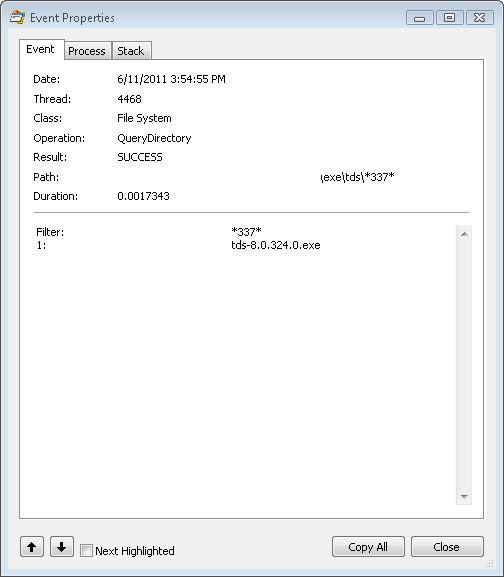Can anyone explain this result? (note: folder name has been obscured)
D:\...\exe\tds>dir *337*
Volume in drive D has no label.
Volume Serial Number is 4279-DECE
Directory of D:\...\exe\tds
05/12/2011 02:39 PM 12,432,384 tds-8.0.324.0.exe
11/04/2011 02:41 PM 13,268,480 tds-8.0.337.0.exe
2 File(s) 25,700,864 bytes
0 Dir(s) 129,676,939,264 bytes free
D:\...\exe\tds>dir *337.0.exe
Volume in drive D has no label.
Volume Serial Number is 4279-DECE
Directory of D:\...\exe\tds
11/04/2011 02:41 PM 13,268,480 tds-8.0.337.0.exe
1 File(s) 13,268,480 bytes
0 Dir(s) 129,676,324,864 bytes free
I can’t figure out why tds-8.0.324.0.exe is matching *337*, in this folder. There are lots of other files in the folder with similar names that don’t match. chkdsk returned no errors. Any ideas?
Update 4:45pm: I did a little more investigation. The error can be reproduced on other computers, so it is not related to the state of the filesystem, or the path name. The following command narrowed down the match a little:
c:\temp\tds>dir *d337*
Volume in drive C is OS
Volume Serial Number is 8036-7CEB
Directory of c:\temp\tds
12/05/2011 02:39 PM 12,432,384 tds-8.0.324.0.exe
1 File(s) 12,432,384 bytes
0 Dir(s) 12,700,200,960 bytes free
But the following did not match:
c:\temp\tds>dir td337*
Volume in drive C is OS
Volume Serial Number is 8036-7CEB
Directory of c:\temp\tds
File Not Found
Curiouser and curiouser. Procmon did not provide much insight into the issue:

Where to now? It’s Sunday afternoon, and I don’t feel like breaking out a kernel debugger to trace that any further right now.
Update 7:30pm: Well, I was puzzled so I did a little more research. And ran across a mention of 8.3 filenames. All of a sudden everything clicked into place.
D:\...\exe\tds>dir /x *337*
Volume in drive D has no label.
Volume Serial Number is 4279-DECE
Directory of D:\...\exe\tds
05/12/2011 02:39 PM 12,432,384 TDD337~1.EXE tds-8.0.324.0.exe
11/04/2011 02:41 PM 13,268,480 TDD938~1.EXE tds-8.0.337.0.exe
2 File(s) 25,700,864 bytes
0 Dir(s) 129,670,885,376 bytes free
Yes, even today DOS comes back to bite us. So just beware when doing wildcard matches — especially with that old favourite del.
